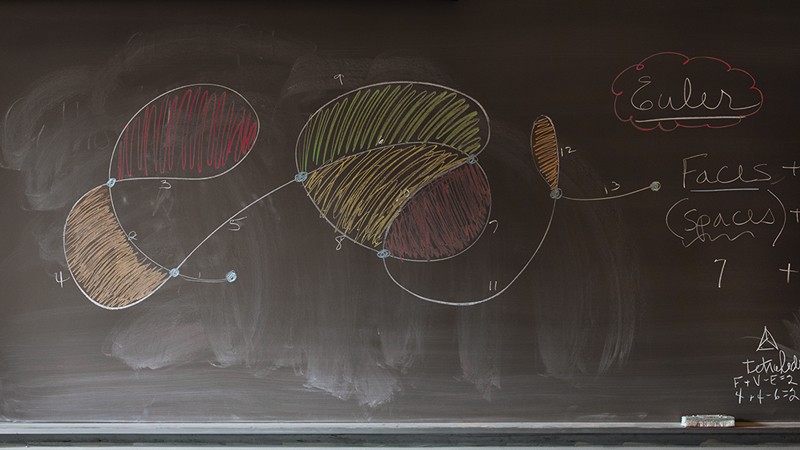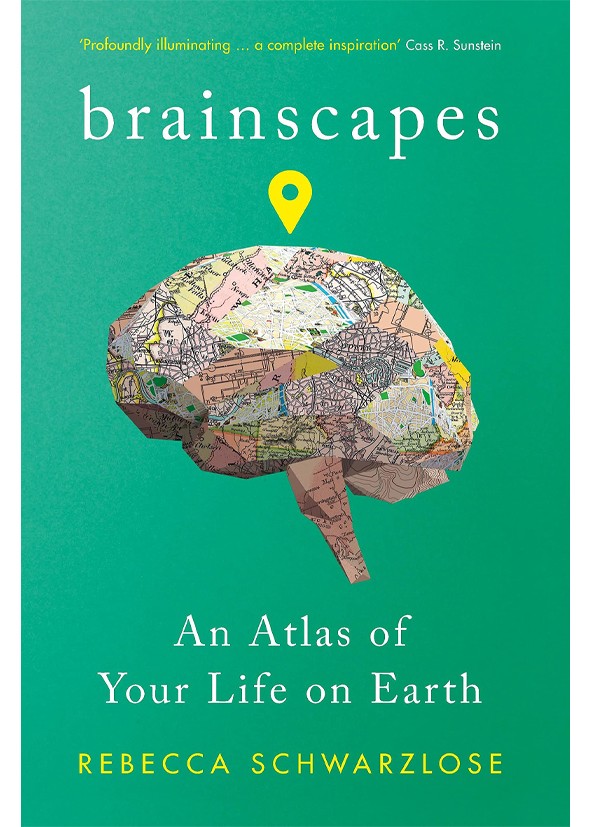The Extended Mind: The Power of Thinking Outside the Brain
Annie Murphy Paul
Houghton Mifflin Harcourt (2021)
Can our bodies, tools and surroundings take more of the cognitive load?

Some mathematicians find chalk and board so essential for thinking that their tools are celebrated in a 2021 book, Do Not Erase (short review in Postscript at end of this post).
6 September 2021 (Milos, Greece) – The disembodied brain in a vat is an amusing trope of science fiction. Without a vat, the brain needs a body to generate the nutrients to maintain itself and to furnish information about its environment. Sight, hearing, touch, taste, smell and proprioception help us to navigate, and find food or reproductive partners. Science fiction assumes that, with those basic needs taken care of by the vat, the brain can devote its full energies to developing genius intelligence.
Not so, argues science writer Annie Murphy Paul. Her book The Extended Mind lays out arguments that the body – and the world more generally – is part of being smart. The human brain is a structure with serious limits: in memory, in attention, in handling abstract concepts. But it can extend its thinking apparatus beyond its skull-bound membranes. Given that the modern world is ever more centred on non-intuitive ideas and abstractions, we need all the help that mind extension can offer. Society fails to recognize this, is Paul’s claim.
From spoons to semiconductors — we are what we make
We can, for example, offload information from our heads to Post-it notes, phones, computers, friends, colleagues or our gesturing hands. Or we can transform ideas into concrete objects by building models — from blocks, bricks or bits. With the information thus externalized, we can contemplate and manipulate it from a distance — without paying the high cognitive price of having to hold it in the front of our minds while doing so. Relieved, the brain has more resources for understanding or problem-solving. Perhaps that’s why Leonardo da Vinci drew and crafted, or nineteenth-century chemist John Dalton built atomic models out of balls and sticks. There’s many a mathematician who still uses chalk and board like a plug-in hard drive.
I don’t completely buy the premise that today’s society quashes or undervalues “extensions”. Collaboration is ubiquitous from schools to CERN’s high-energy physics experiments. Or perhaps the issue is that digital extensions are greatly privileged over physical ones: too much Slack, not enough pacing (like Charles Darwin along his “thinking path”). But the framing of the brain–body complex as a borderless thinking apparatus is interesting, bringing together a wide range of research, from education and business practice to psychology and cognitive neuroscience.
Hacks and hands
Paul explores the many tricks that can foster people’s ability to recall, focus and analyse. One is the venerable memory palace, in which items to be remembered are associated with a particular spot. Ancient Greek and Roman orators used this “method of loci” to mentally attach points to be remembered in their speeches to, for example, the windows of a building, or the shop fronts in a street.
The method has been validated in scientific studies. It exploits the brain’s built-in navigational system, and cognitive neuroscientists have shown that memory champions – and London taxi drivers – activate brain regions associated with spatial memory and navigation to a greater degree than average.
A grasp on human thinking
The simple act of gesturing while speaking can also drop what Paul describes as “mental hooks” into, say, a lecture to be learnt, to help reel in that piece of information when at the podium. Movements, even the fidgety ones that a standing desk can engender, might help concentration. Pity the students required to sit still at their desks, she writes.
The book delves into the issue of how our surroundings affect how we think. Why, for example, does being in nature reduce the stress that erodes our cognitive powers, and why is natural light important in a workplace? Humans have, after all, evolved to function optimally in an outdoor environment. Paul lobbies for biophilic architecture that builds in generous windows and greenery. She lauds the design of the Salk Institute for Biological Studies in San Diego, California: a modern take on the medieval monastery, with spaces for meeting and talking, and others for solitary contemplation. These, she says, serve researchers’ dual need to think through difficult concepts without distraction, and to engage in fruitful discussions.
The latter exploits the mind extension of “thinking with our relationships”. The catalogue of studies on this phenomenon looks at the various ways in which social interaction – with peers, with experts and through teaching, arguing or group training – can help learning or analysis. Tapping into the hive mind, she argues, can spread the cognitive load.
Science in hand: how art and craft can boost reproducibility
So much research is covered at speed that it’s not always clear what’s robust and what’s flimsy. Given that psychology has known reproducibility problems, these distinctions are important. The book contains more than 70 pages of notes for those who want to follow up on some of the many studies mentioned. But somehow, the whole is less than the sum of the parts.
The “how to” element, so beloved of publishers, seems rather one-size-fits-all. To live a more intelligent life, Paul recommends gesturing freely, enacting abstract academic concepts with our bodies (perhaps the annual Dance Your Ph.D. contest is on to something?), learning in groups, and many other activities that could help only in particular circumstances. She does not consider important issues of personality that would affect the value of many such measures. Would an introvert gain as much from group learning as an extrovert? Would an uncoordinated person take as much as a graceful one from physical action? Such questions are not addressed.
Still, many of the messages are indisputable. Evolution has built our brains to respond to signals that constantly monitor our environment and our bodies. Society should indeed give more thought to its environment. Individuals should heed what their bodies are telling them. But let’s not exaggerate: it’s the brain, and not the body, that does the actual thinking.
* * * * * * * * *
POSTSCRIPT
Do Not Erase
Jessica Wynne Princeton Univ. Press (2021)
A blackboard filled with mathematics by Albert Einstein takes pride of place in a museum in Oxford, UK. Ironically, Einstein opposed its preservation — unlike 111 mathematicians whose hugely varying chalkboards feature in photographs by Jessica Wynne. The simplest, by Tadashi Tokieda, shows a white circle outlined against black, labelled ‘WHITE’; a second circle, filled with white, is labelled ‘BLACK’. Tokieda compares watching a board being chalked with listening to music “note by note”. This is an original, elegant, if baffling book.
And one other related book I read which I’ll insert here:

If each human brain neuron were connected randomly to the other 86 billion, notes neuroscientist Rebecca Schwarzlose, the brain would be more than 20 kilometres wide. Instead, they link through maps of the “body, senses, movements, and crucial sources of information”. These “brainscapes” are the complex, partially understood subject of her clear, often vivid history. Much evidence derives from people with brain damage or other conditions, such as blind children who can remap their visual cortex for uses such as language processing.